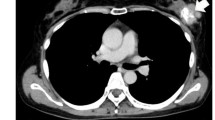Abstract
Osteosarcoma is an aggressive mesenchymal malignancy of the bone. Patient-derived models are essential tools for elucidating the molecular mechanisms associated with poor prognosis and the development of novel anticancer drugs. This study described the establishment of a patient-derived cancer model of osteosarcoma. Primary osteosarcoma tumor tissues were obtained from an osteosarcoma patient and inoculated in the skin of immunodeficient mice, followed by transplantation to other mice upon growth. Cells were maintained in monolayer cultures, and the capability of spheroid formation was assessed by seeding the cells on culture dishes. The invasion ability of cells was monitored by Matrigel assay, and genomic and proteomic backgrounds were examined by mass spectrometry. A cell line was established from patient-derived tumors and showed similar histology to that of the primary tumor tissue. Additionally, these cells formed spheroids on low-attachment tissue-culture dishes and exhibited invasive capabilities, and we confirmed that the genomic backgrounds were similar between patient-derived xenograft tumors and the cell line. Furthermore, the proteome of the patient-derived tumors and the cells exhibited similar, but not identical, patterns to that of the original tumor tissue. Our results indicated that this patient-derived xenograft model and cell line would be useful resources for osteosarcoma research.






Similar content being viewed by others
References
The International Cell Line Authentication Committee. Available via http://standards.atcc.org/kwspub/home/the_international_cell_line_authentication_committee-iclac_/
Altermann E, Klaenhammer TR (2005) PathwayVoyager: pathway mapping using the Kyoto encyclopedia of genes and genomes (KEGG) database. BMC Genomics 6(60):60
Baehrecke EH, Dang N, Babaria K, Shneiderman B (2004) Visualization and analysis of microarray and gene ontology data with treemaps. BMC Bioinf 5:84
Capes-Davis A, Dirks W, MacLeod R, Uphoff C (2014) Quality matters: cell lines and their use in research. GIT Lab J Eur 17:12–13
Igarashi K, Murakami T, Kawaguchi K, Kiyuna T, Miyake K, Zhang Y, Nelson SD, Dry SM, Li Y, Yanagawa J, Russell TA, Singh AS, Tsuchiya H, Elliott I, Eilber FC, Hoffman RM (2017) A patient-derived orthotopic xenograft (PDOX) mouse model of a cisplatinum-resistant osteosarcoma lung metastasis that was sensitive to temozolomide and trabectedin: implications for precision oncology. Oncotarget 8:62111–62119
Isakoff MS, Bielack SS, Meltzer P, Gorlick R (2015) Osteosarcoma: current treatment and a collaborative pathway to success. J Clin Oncol 33:3029–3035
Kondo T, Seike M, Mori Y, Fujii K, Yamada T, Hirohashi S (2003) Application of sensitive fluorescent dyes in linkage of laser microdissection and two-dimensional gel electrophoresis as a cancer proteomic study tool. Proteomics 3:1758–1766
Li JZ, Tian ZQ, Jiang SN, Feng T (2014) Effect of variation of ABCB1 and GSTP1 on osteosarcoma survival after chemotherapy. Genet Mol Res : GMR 13:3186–3192
Liu JQ, Bai X, Duan DC, Dou AX (2015) Role of five small nucleotide polymorphisms in the VEGF gene on the susceptibility to osteosarcoma and overall survival of patients. Oncol Lett 10:1481–1486
Mirabello L, Troisi RJ, Savage SA (2009) Osteosarcoma incidence and survival rates from 1973 to 2004: data from the surveillance, epidemiology, and end results program. Cancer 115:1531–1543
Pelletier J, Thomas G, Volarevic S (2018) Ribosome biogenesis in cancer: new players and therapeutic avenues. Nat Rev Cancer 18:51–63
Peltonen K, Colis L, Liu H, Trivedi R, Moubarek MS, Moore HM, Bai B, Rudek MA, Bieberich CJ, Laiho M (2014) A targeting modality for destruction of RNA polymerase I that possesses anticancer activity. Cancer Cell 25:77–90
Sakumoto M, Oyama R, Takahashi M, Takai Y, Kito F, Shiozawa K, Qiao Z, Endo M, Yoshida A, Kawai A, Kondo T (2018) Establishment and proteomic characterization of patient-derived clear cell sarcoma xenografts and cell lines. In vitro Cell Dev Biol Animal 54:163–176
Savage SA, Mirabello L (2011) Using epidemiology and genomics to understand osteosarcoma etiology. Sarcoma 2011(548151):1–13
Snijders AM, Nowak N, Segraves R, Blackwood S, Brown N, Conroy J, Hamilton G, Hindle AK, Huey B, Kimura K, Law S, Myambo K, Palmer J, Ylstra B, Yue JP, Gray JW, Jain AN, Pinkel D, Albertson DG (2001) Assembly of microarrays for genome-wide measurement of DNA copy number. Nat Genet 29:263–264
Tomayko MM, Reynolds CP (1989) Determination of subcutaneous tumor size in athymic (nude) mice. Cancer Chemother Pharmacol 24:148–154
Wisniewski JR, Zougman A, Nagaraj N, Mann M (2009) Universal sample preparation method for proteome analysis. Nat Methods 6:359–362
Yang D, Okamoto K (2010) Structural insights into G-quadruplexes: towards new anticancer drugs. Future Med Chem 2:619–646
Acknowledgments
We appreciate Drs. M. Endo, Y. Minami, K. Shimizu, T. Mori, T. Uehara M. Sugawara, Y. Araki, S. Toki, and Ms. R. Nakano, Division of Musculoskeletal Oncology, National Cancer Center Hospital, for sampling tumor-tissue specimens from surgically resected materials. We would also like to thank Editage (www.editage.jp) for English-language editing and their constructive comments on the manuscript. This research was supported by the National Cancer Center Research and Development Fund (grant nos. 26-A-3, 26-A-9, and 29-A-2), and by the Fundamental Innovative Oncology Core in the National Cancer Center.
Author information
Authors and Affiliations
Corresponding author
Ethics declarations
This study was approved by the Ethics Committee of the National Cancer Center, and both informed assent and informed consent were obtained from the patient and his parents.
Additional information
Editor: Tetsuji Okamoto
Rights and permissions
About this article
Cite this article
Kito, F., Oyama, R., Sakumoto, M. et al. Establishment and characterization of novel patient-derived osteosarcoma xenograft and cell line. In Vitro Cell.Dev.Biol.-Animal 54, 528–536 (2018). https://doi.org/10.1007/s11626-018-0274-2
Received:
Accepted:
Published:
Issue Date:
DOI: https://doi.org/10.1007/s11626-018-0274-2




